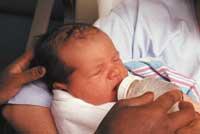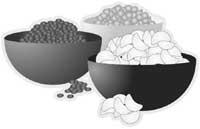Feeding from the first year to adolescence
2002/11/01 Lorenzo, Arantza | Uranga, Ane Miren Iturria: Elhuyar aldizkaria
In fact, the first year of the birth of a child triples its weight. But to quadruple it needs one more year. Therefore, physical growth is much slower and stable in the second year and successive. But in this period there is an important social, cognitive and emotional development of the child, and when learning to feed we will have to take it into account.

The need for energy of a child, in addition to his age, height and weight, is conditioned by his physical activity. But, on average, the child from 1 to 3 years will need 1,300 kcal a day, 1,800 kcal in 4 to 6 years and 2,000 kcal in 7 to 10 years. An adequate distribution of energy at this time would be: 50-60% carbohydrate, 25-35% fat and 12-15% protein.
The protein needs are greater when the child is small and decrease as it increases. The child from 1 to 3 years needs approximately 1.2 g of protein per kilo weighing, 4 to 5 years 1,1 g and 7 to 10 years 1 g of protein per kilo.
Mineral salts and vitamins are also very necessary for the child to have normal growth and development. Among them, the most important for the first ten years of the child are calcium, iron, zinc and vitamin D, among others. Therefore, the distribution of food groups for this age group is proposed (see table).
| Group of food | 1-3 years | 4-6 years old | 7-10 years |
Dairy products Dairy products | 100 ml/g; 4-5 days | 150 ml/g; 3-4 daily | 240 ml/g; 2-3 days |
Fish of meat | 50 g every 4 times per week | 50-100 g, 3-4 times per week | 100 to 150 g, 3-4 times per week |
Eggs Eggs Eggs Eggs | 2-3 weeks | 2-3 weeks | 3-4 weeks |
Sausages Sausages | 20 g; 2 to 4 times per week | 25 g; 2-4 times per week | 30 g; 2-4 times per week |
Appointments - Appointments | Half cup, every day | Semi-complete cup, every day | Two cups every day |
Bread Bread Bread Bread | A good slice, every day | Two good slices daily | 3-4 beautiful slices daily |
Pasta of rice | 40 g per week | 50 g every week | 60 g per week |
Fruit of fruit | 1,5-2 specimens daily | 2-3 units daily | 3 specimens daily |
Vegetables and vegetables | Daily dish: cooked or mashed | Daily dish: start to put salad | Daily dish: everything |
Green beans Green beans | 40 g; twice a week. Best in puree | 50 g, 2 times per week | 60 g; 2 times per week |
The family notably influences the development of eating habits. The behavior of parents with food conditions in part that the child accepts or rejects certain foods.
When making a meal, it is necessary to give importance to that moment, to dedicate time to eat. Eating fast, in a hurry, has negative consequences on the child's eating habits. The correct distribution of meals is also very important. The child must have at least 4 meals a day (breakfast, food, snack and dinner) and in some situations it will be necessary up to 5 meals. As we explained in the previous number how good breakfast is, we will go to the food. At lunch we will always have first (vegetables, rice, pasta, salad…), second course (meat, fish, green beans with rice…) and dessert (fruit or dairy).
For snack, the ideal is to eat fruit and sandwiches (ham, cheese, quince, chocolate, tuna, nuts… every day). Finally, dinner should be light: first vegetables or soup, then fish or tortilla and fruit or dairy.
Celiac disease
Also called gluten enteropathy. In people with this disease, the component of gluten gliadin affects the small bowel rents. As a result, the absorption of most foods decreases considerably, with the following symptoms appearing:
- Diarrhea, voluminous excrements rich in fatty acids. This means a loss of weight and, if the disease persists, a notable lack of food.
- Anemia because the body absorbs less iron and folic acid enough.
- There may also be bone pain and broken bones, since the absorption of calcium and vitamin D is damaged.
The diagnosis is made, first of all, by an analysis of the excrements to detect the presence of unabsorbed fats and fatty acids. The jejunum biopsy (second part of the small intestine) is then performed, where it is clearly seen if the hairs are atrophied.
In 1953, Dutch researchers found that the symptoms of celiac disease in children quickly disappeared by eliminating wheat, barley, rye, and oats from the diet. Then they realized that the gliadine of the gluten that was in those jitos caused damage in the intestinal veils.

It is true that consuming a gluten-free diet is an important change in diet. And in our society there is a lot of food based on wheat. However, since the market offer is more and more wide, the possibilities are more varied for those affected by this disease and can calmly consume corn, millet, rice, soy, tapioca, quinoa… and the flours and products made with them all.
Yes, the exact reading of the labels will be essential, since sometimes gluten-free is added directly to foods during processing and sauces, etc. this substance is also used for its elaboration. Be careful with the following foods (always check the labels well):
- Sausages, sausages, vegetable meats, fried… in their production, often, quotations with gluten are used.
- Precooked foods with sauce, whose production is often made with wheat.
- Vegetables and legumes that sell in can.
- Leftover soups.
- Biscuits, pasta, sweets…
- Teas with beer, gin, whisky and malted barley.
However, they can eat calm:
- All dairy products.
- All meat and fish in a natural way and without previous preparation.
- All fresh or frozen vegetables and all fresh fruits and cans.
- Green beans without previous preparation.
- Sugars, jams, chocolate…
- Horses, flours, pasta and corn breads, rice, millet, quincho and nuts.
- Wine, coffee, carbonated drinks…
As it is a chronic disease, when improving the symptoms it is not convenient to relax and retake gluten. Small symptoms appear quickly, but severe (malnutrition, anemia...) begin to be noticed in eight weeks. In addition, the ingestion of gluten for a time causes the diet not to improve the disease and generate more serious diseases: chronic ulcerative jeiunoileitis, cancer and lymphomas… Maintaining a gluten-free diet reduces all these risks.

Gai honi buruzko eduki gehiago
Elhuyarrek garatutako teknologia






